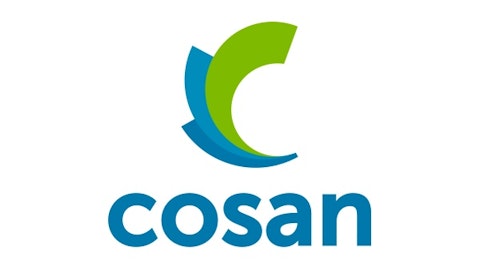A leading manufacturer and marketer of a wide array of branded consumer foods, General Mills Inc. (NYSE:GIS) has outperformed the Dow Jones Industrial Average so far in 2013, rising 16.48% compared to the 15.34% return offered by the broader market.

With the company trading within $4 of all-time highs, is General Mills, Inc. (NYSE:GIS) a essential part of a healthy portfolio, or should investors stay away from this company?

Strengths:
- Historic Revenue Growth: In 2003, General Mills, Inc. (NYSE:GIS) reported revenue of $10.50 billion; in 2012, the company announced revenue of $16.65 billion, representing year over year annual growth of 5.26%, a strong trend that is highly anticipated to sustain into the future, with projections placing 2017 revenue at $20.61 billion. This growth has been a result of consistent product innovation and explosive international growth.

- Institutional Vote of Confidence: 89% of shares outstanding are held by institutional investors, displaying the confidence some of largest investors in the world have in the company and its future.
- Relatively Low Volatility: Currently, General Mills carries a beta ratio of 0.16, representing a company trading with considerably less volatility than the overall market, a major strength for long-term investors.
- Reasonable Valuation: At the moment, the company possesses a price to earnings ratio of 17.29, a price to book ratio of 4.75, and a price to sales ratio of 1.82, all of which indicate a company trading with a reasonable valuation.
- Strong Cash Flow: In 2012, General Mills, Inc. (NYSE:GIS) produced $1.24 billion in cash flow, allowing the company to pay out its dividend yielding 3.23%.
- Diversified & Established Nature: General Mills possesses a distinguished portfolio of leading brands, derives United States revenue from several different channels, possesses a global presence, and employs 35,000. With this diversified and established nature comes a greater level of security and predictability for investors.

- Sustaining Profit Margin: Over the past decade the company’s profit margin has gyrated around the current 11.09% level, representing a company which is able to perform consistently.

Weaknesses:
- Net Debt: The company’s $734.90 million of cash and cash equivalents is outweighed by its debt load of $5.57 billion, resulting in a substantial net debt of $4.83 billion, a minor financial weakness of the business.

Opportunities:
- Dividend Growth: Since implementing their dividend program in 1992, the company has consistently raised their dividend payouts, and is widely anticipated to continue to do so into the future.

- Product Innovation: General Mills, Inc. (NYSE:GIS) is constantly working towards launching the next major alteration or product to one of its brands, from a new flavor of Nature Valley granola bars or a new line of Progreso soups; any further product innovations could spark customer interest and fuel sales.
- Latin America: From 2011 to 2012, the company experienced 11% year over year annual growth in its Latin American region, driven by the launch of several new products distinct to the region, and further accelerated growth from this region is highly anticipated as economic prosperity increases.
- Canada: Year over year annual growth from 2011 to 2012 in the company’s Canada region was 29%, driven partially by Liberte (Greek yogurt), up from growth of only 8% year-over-year annual growth from the year before. Further premium performance from the Canada region could fuel overall sales growth.
- Asia/Pacific: The company’s Asia-Pacific region has been among the fastest growing, with year-over-year growth from 2010 to 2011 equaling 14% and year-over-year growth from 2011 to 2012 equaling 21%; further strong performance in this critical region is a prime opportunity as General Mills, Inc. (NYSE:GIS) rolls out more products adaptable to that market.
- Results from R&D Spending: In 2012, General Mills poured $245 million into research and development, and any results from this investment could lead to new products and sales growth.

Threats:
- Rising Ingredient Prices: Any rise in the ingredient prices the company utilizes to make its products could squeeze margins or lead to lost customers if prices were raised.
Competitors
Major publicly traded competitors of General Mills include Kellogg Company (NYSE:K), The J.M. Smucker Company (NYSE:SJM), Mondelez International Inc (NASDAQ:MDLZ), and Unilever N.V. (NYSE:UN).
Kellogg is valued at $22.42 billion, pays out a dividend yielding 2.84%, and carries a price to earnings ratio of 24.53. Kellogg is the largest and most prominent threat to General Mills, Inc. (NYSE:GIS), as Kellogg Company (NYSE:K)’s core business is concentrated in the cereal and breakfast sector. Late in 2011, the company’s TTM profit margin fell below the 10% mark, and currently sits at the 6.25% level.
The J.M. Smucker Company (NYSE:SJM) is valued at $10.95 billion, pays out a dividend yielding 2.06%, and carries a price to earnings ratio of 21.51. J.M. Smucker’s brand portfolio encompasses jams, jellies, preserves, and other items, but the core of their business does not compete against General Mills. Smucker’s business model is strong and profitable with a TTM profit margin of 8.76%.
Mondelez International Inc (NASDAQ:MDLZ) is valued at $52.60 billion, pays out a dividend yielding 1.76%, and carries a price to earnings ratio of 29.77. Mondelez’s vast brand portfolio includes 52 snack food and beverages brands. The company recently spun off from Kraft Foods, taking the higher growth snack segment with it. Mondelez’s business model is fundamentally sound with a TTM profit margin of 9.08%.
Unilever is valued at $115.48 billion, pays out a dividend yielding 3.15%, and carries a price to earnings ratio of 20.40. Unilever’s product portfolio not only includes food, but also possesses a dominant force in the personal care, home care, and refreshment industries. Fundamentally the company’s business model is healthy with a TTM profit margin of 9.61%.
The Foolish Bottom Line
Financially, the only weakness of the company is its minor debt load. The company possesses a historic track record of solid revenue growth, a growing dividend, and a broad and diversified business which can withstand the difficulties of economic downfall. Looking forward, the company will derive growth from its Latin America and Asia Pacific regions, and should experience slight growth domestically due to product innovation. All in all, General Mills, Inc. (NYSE:GIS) is a recession proof business and is a tremendously safe long-term investment, however investors should wait for a pullback from these all-time highs before pouring in.
Ryan Guenette has no position in any stocks mentioned. The Motley Fool has no position in any of the stocks mentioned.
The article A Staple of the Global Consumer Foods Industry originally appeared on Fool.com.
Copyright © 1995 – 2013 The Motley Fool, LLC. All rights reserved. The Motley Fool has a disclosure policy.




